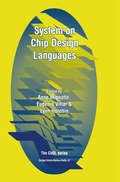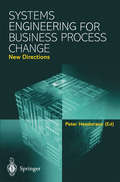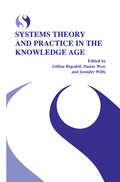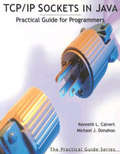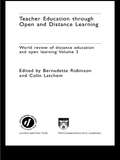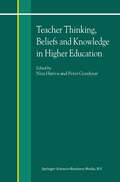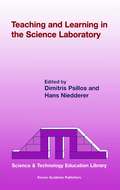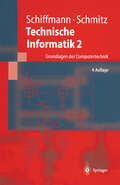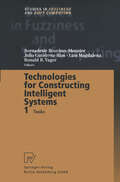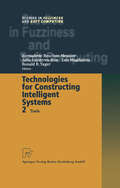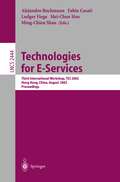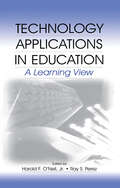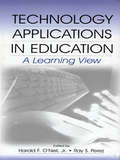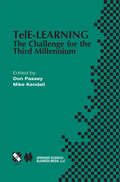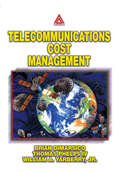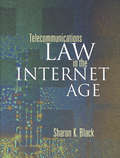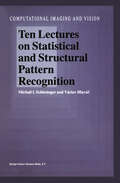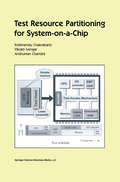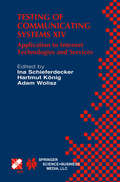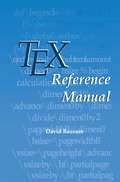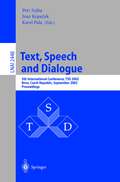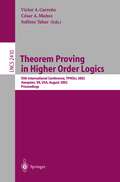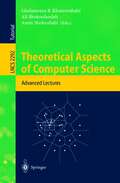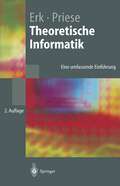- Table View
- List View
System on Chip Design Languages: Extended papers: best of FDL’01 and HDLCon’01
by Anne Mignotte Eugenio Villar Lynn HorobinThis book is the third in a series of books collecting the best papers from the three main regional conferences on electronic system design languages, HDLCon in the United States, APCHDL in Asia-Pacific and FDL in Europe. Being APCHDL bi-annual, this book presents a selection of papers from HDLCon'Ol and FDL'OI. HDLCon is the premier HDL event in the United States. It originated in 1999 from the merging of the International Verilog Conference and the Spring VHDL User's Forum. The scope of the conference expanded from specialized languages such as VHDL and Verilog to general purpose languages such as C++ and Java. In 2001 it was held in February in Santa Clara, CA. Presentations from design engineers are technical in nature, reflecting real life experiences in using HDLs. EDA vendors presentations show what is available - and what is planned-for design tools that utilize HDLs, such as simulation and synthesis tools. The Forum on Design Languages (FDL) is the European forum to exchange experiences and learn of new trends, in the application of languages and the associated design methods and tools, to design complex electronic systems. FDL'OI was held in Lyon, France, around seven interrelated workshops, Hardware Description Languages, Analog and Mixed signal Specification, C/C++ HW/SW Specification and Design, Design Environments & Languages, Real-Time specification for embedded Systems, Architecture Modeling and Reuse and System Specification & Design Languages.
Systems Engineering for Business Process Change: Collected Papers from the EPSRC Research Programme
by Peter Henderson MSc, PhD, MBCSSystems Engineering for Business Process Change: New Directions is a collection of papers resulting from an EPSRC managed research programme set up to investigate the relationships between Legacy IT Systems and Business Processes. The papers contained in this volume report the results from the projects funded by the programme, which ran between 1997 and 2001. An earlier volume, published in 2000, reported interim results. Bringing together researchers from diverse backgrounds in Computer Science, Information Systems, Engineering and Business Schools, this book explores the problems experienced by IT-dependent businesses that have to implement changing business processes in the context of their investment in legacy systems. The book presents some of the solutions investigated through the collaborations set up within the research programme. Whether you are a researcher interested in the ideas that were generated by the research programme, or a user trying to understand the nature of the problems and their solutions, you cannot fail to be inspired by the writings contained in this volume.
Systems Theory and Practice in the Knowledge Age
by Gillian Ragsdell Daune West Jennifer WilbyWelcome to the proceedings of the Seventh International Conference of the UK Systems Society being held at York University, United Kingdom from July 7th to 10th, 2002. It is a pleasure to be able to share with you this collection ofpapers that have been contributed by systems thinkers from around the world. As with previous UKSS conferences, the aim ofthis conference is to encourage debate and promote development of pertinent issues in systems theory and practice. In current times where the focus has moved from 'information' to 'knowledge' and where 'knowledge management', of everyday speak, it seemed fitting to 'knowledge assets' and so on, have become part offer a conference title of'Systems Theory and Practice in the Knowledge Age'. In keeping with another tradition of previous conferences, the UKSS Conference 2002 Committee decided to compile a collection ofdelegates' papers before the event as a platform from which to launch discussions in York. Ideas presented in the following papers will, undoubtedly, be developed during the dialogue generated at the conference and new papers will emerge. In his abstract for his plenary at this conference, Professor Peter Checkland throws down the gauntlet to systems thinking and its relevance in the knowledge age with the following statement: "30 Years In The Systems Movement: Disappointments I Have Known and Hopes/or the Future Springing from a lunchtime conversation at an American University, the Systems Movement is now nearly 50 years old.
TCP/IP Sockets in Java: Practical Guide for Programmers (The Practical Guides)
by Kenneth L. Calvert Michael J. DonahooMost Internet applications use sockets to implement network communication protocols. TCP/IP Sockets in Java: Practical Guide for Programmers, with its focused, tutorial-based coverage, helps you master the tasks and techniques essential to virtually all client-server projects using sockets in Java. Later chapters teach you to implement more specialized functionality; incisive discussions of programming constructs and protocol implementations equip you with a deeper understanding that is invaluable for meeting future challenges. No other resource presents so concisely or so effectively the exact material you need to get up and running with Java sockets programming right away. For those who program using the C language, be sure to check out this book's companion, TCP/IP Sockets in C: Practical Guide for Programmers.Concise, no-nonsense explanations of issues often troublesome for students, including message construction and parsing, underlying mechanisms and Java I/OComprehensive example-based coverage of the most important TCP/IP techniques-including iterative and threaded servers, timeouts and asynchronous message processingIncludes a detailed, easy-to-use reference to the relevant JAVA class librariesProvides a guide to common errors and a reference offering detailed documentation of the sockets interfacePerfect for a practitioner who may even want just to "look into" this technology.Provides tutorial-based instuction in key sockets programming techniques, focusing exclusively on Jva and complemented by example code.Covers challenging sockets programming issues: message construction and parsing, underlying TCP/IP protocol mechanisms, Java I/O, iterate and threaded servers, and timeouts.Includes references to the relevant Java class libraries that often go beyond the "official" Java documentation in clarity and explanation.
Teacher Education Through Open and Distance Learning: World review of distance education and open learning Volume 3
by Bernadette Robinson Colin LatchemHow can open and distance learning and information and communications technology (ICT) provide us with more - and better - teachers?Open and distance learning is increasingly used in teacher education in developing and developed countries. It has the potential to strengthen and expand the teaching profession of the twenty-first century and to help achieve the target of education for all by 2015. Teacher Education Through Open and Distance Learning examines the case for using open and distance learning and ICT to train our educators. It describes and analyses the ways in which these methods and technologies are used for:*initial teacher training and continuing professional development*training principals and school managers*training those who provide non-formal adult and community education*communities of practice and sharing of knowledge and ideas within the teaching professionIt also discusses the policy-making, management, technology, costing, evaluation and quality assurance aspects of this work. The contributors are outstanding practitioners in the field. The first review in over a decade, Teacher Education Through Open and Distance Learning draws on wide-ranging and international experience to summarise the strengths and weaknesses of new approaches to the education of teachers. It offers invaluable guidance to policymakers, planners, headteachers and teachers.
Teacher Education Through Open and Distance Learning: World review of distance education and open learning Volume 3 (World Review Of Distance Education And Open Learning Ser. #Vol. 4)
by Bernadette Robinson Colin LatchemHow can open and distance learning and information and communications technology (ICT) provide us with more - and better - teachers?Open and distance learning is increasingly used in teacher education in developing and developed countries. It has the potential to strengthen and expand the teaching profession of the twenty-first century and to help achieve the target of education for all by 2015. Teacher Education Through Open and Distance Learning examines the case for using open and distance learning and ICT to train our educators. It describes and analyses the ways in which these methods and technologies are used for:*initial teacher training and continuing professional development*training principals and school managers*training those who provide non-formal adult and community education*communities of practice and sharing of knowledge and ideas within the teaching professionIt also discusses the policy-making, management, technology, costing, evaluation and quality assurance aspects of this work. The contributors are outstanding practitioners in the field. The first review in over a decade, Teacher Education Through Open and Distance Learning draws on wide-ranging and international experience to summarise the strengths and weaknesses of new approaches to the education of teachers. It offers invaluable guidance to policymakers, planners, headteachers and teachers.
Teacher Thinking, Beliefs and Knowledge in Higher Education
by PeterGoodyear NiraHativaThis volume addresses the important problem of understanding good university teaching, and focuses on the thinking, beliefs, and knowledge, which accompany teachers' actions. It is the first book to address this area and it promises to become a landmark volume in the field - helping us to understand a complex area of human activity and improve both teaching and learning. It is for education researchers, staff/faculty developers and educational developers.
Teaching and Learning in the Science Laboratory (Contemporary Trends and Issues in Science Education #16)
by Dimitris Psillos H. NieddererThis book aims to improve the design and organization of innovative laboratory practices and to provide tools and exemplary results for the evaluation of their effectiveness, adequate for labwork in order to promote students' scientific understanding in a variety of countries. The papers are based on research and developmental work carried out in the context of the European Project "Labwork in Science Education" (LSE). This substantial and significant body of research is now made available in English.
Technische Informatik 2: Grundlagen der Computertechnik (Springer-Lehrbuch)
by Wolfram Schiffmann Robert SchmitzDie beiden Bände Technische Informatik bieten einen verständlichen Einstieg in dieses wichtige Teilgebiet der Informatik. Leser mit unterschiedlichen Vorkenntnissen gewinnen schrittweise einen Überblick über die benötigten elektrotechnischen und elektronischen Grundlagen. Leicht verständliche Einführung für Anfangssemester. Fortführung des in Technische Informatik I behandelten Stoffes.
Technologies for Constructing Intelligent Systems 1: Tasks (Studies in Fuzziness and Soft Computing #89)
by Bernadette Bouchon-Meunier Julio Gutierrez-Rios Luis Magdalena Ronald R. YagerIntelligent systems enhance the capacities made available by the internet and other computer-based technologies. This book deals with the theory behind the solutions to difficult problems in the construction of intelligent systems. Particular attention is paid to situations in which the available information and data may be imprecise, uncertain, incomplete or of linguistic nature. Various methodologies for these cases are discussed, among which are probabilistic, possibilistic, fuzzy, logical, evidential and network-based frameworks. One purpose of the book is to consider how these methods can be used cooperatively. Topics included in the book include fundamental issues in uncertainty, the rapidly emerging discipline of information aggregation, neural networks, bayesian networks and other network methods, as well as logic-based systems.
Technologies for Constructing Intelligent Systems 2: Tools (Studies in Fuzziness and Soft Computing #90)
by Bernadette Bouchon-Meunier Julio Gutierrez-Rios Luis Magdalena Ronald R. YagerIntelligent systems enhance the capacities made available by the internet and other computer-based technologies. This book is devoted to various aspects of the management of intelligent systems. Particular attention is paid to situations in which the available information and data may be imprecise, uncertain, incomplete or of linguistic nature. Various methods developed to manage such information are discussed in the context of several domains of application. Topics included in the book include preference modelling and decision making, learning, clustering and data mining, information retrieval. The paradigm of computing with words is also addressed.
Technologies for E-Services: Third International Workshop, TES 2002, Hong Kong, China, August 23-24, 2002, Proceedings (Lecture Notes in Computer Science #2444)
by Alejandro Buchmann Fabio Casati Ludger Fiege Mei-Chun Hsu Ming-Chien ShanTechnology Applications in Education: A Learning View
by Ray S. Perez Harold F. O'NeilThis volume identifies promising learning, teaching, and assessment strategies for the use and assessment of technology in educational settings, specifically: *educational context (e.g., organizational and structural factors that contribute to the effective use of technology in school settings); *promising learning and teaching strategies; *promising technology-based assessment procedures and methods; *policy implementation issues; and *a summary of current research on the effective use of technology in education. Chapter authors represent a variety of perspectives and disciplines, from computer science, cognitive and educational psychology, and educational administration. Authors represent government, business, and university communities from within and outside the U.S. These multiple perspectives contribute to the overall understanding of current technology use in education and help in identifying future research needs. Technology Applications in Education: A Learning View explores the state of the art of technology in K-16 education from a learning perspective rather than a hardware/software view. It is designed for professionals and graduate students in the educational technology, training, assessment/evaluation, school administration, military psychology, and educational psychology communities. This book is characterized in the following montage of factors: *the primacy of learning as a focus for technology implementation; *a focus on technology uses in K-16 education; *a focus on the assessment of both individuals and teams; *a broad variety of methodological approaches from qualitative to instructional design to quantitative (e.g., structural equation modeling); *a need to support the development of technology-based curriculum and tools; and *a need for theory-driven and evaluation studies to increase our knowledge.
Technology Applications in Education: A Learning View
by Ray S. Perez Harold F. O'NeilThis volume identifies promising learning, teaching, and assessment strategies for the use and assessment of technology in educational settings, specifically: *educational context (e.g., organizational and structural factors that contribute to the effective use of technology in school settings); *promising learning and teaching strategies; *promising technology-based assessment procedures and methods; *policy implementation issues; and *a summary of current research on the effective use of technology in education. Chapter authors represent a variety of perspectives and disciplines, from computer science, cognitive and educational psychology, and educational administration. Authors represent government, business, and university communities from within and outside the U.S. These multiple perspectives contribute to the overall understanding of current technology use in education and help in identifying future research needs. Technology Applications in Education: A Learning View explores the state of the art of technology in K-16 education from a learning perspective rather than a hardware/software view. It is designed for professionals and graduate students in the educational technology, training, assessment/evaluation, school administration, military psychology, and educational psychology communities. This book is characterized in the following montage of factors: *the primacy of learning as a focus for technology implementation; *a focus on technology uses in K-16 education; *a focus on the assessment of both individuals and teams; *a broad variety of methodological approaches from qualitative to instructional design to quantitative (e.g., structural equation modeling); *a need to support the development of technology-based curriculum and tools; and *a need for theory-driven and evaluation studies to increase our knowledge.
TelE-Learning: The Challenge for the Third Millennium (IFIP Advances in Information and Communication Technology #102)
by MikeKendall DonPasseyMany of the early issues in the field of telE-learning are now not only recognised but are being addressed, through professional and staff development routes, through innovative technological solutions, and through approaches and concepts that are better suited to particular educational contexts. TelE-LEARNING: The Challenge for the Third Millennium provides details of the most recent advances in this area.
Telecommunications Cost Management
by William A. Yarberry Jr. Brian DiMarsico Thomas Phelps IVMost telecom books focus on either traditional telecom billing audits or pure technology, with the cost saving ideas buried deep in the text. Busy decision-makers need the specifics quickly, without having to plow through details that do not affect the economics of a project. Telecommunications Cost Management takes cost saving techniques and bring
Telecommunications Law in the Internet Age (ISSN)
by Sharon K. BlackFor companies in and around the telecommunications field, the past few years have been a time of extraordinary change-technologically and legally. The enacting of the Telecommunications Act of 1996 and the development of international trade agreements have fundamentally changed the environment in which your business operates, creating risks, responsibilities, and opportunities that were not there before.Until now, you'd have had a hard time finding a serious business book that offered any more than a cursory glance at this transformed world. But at last there's a resource you can depend on for in-depth analysis and sound advice. Written in easy-to-understand language, Telecommunications Law in the Internet Age systematically examines the complex interrelationships of new laws, new technologies, and new business practices, and equips you with the practical understanding you need to run your enterprise optimally within today's legal boundaries.* Offers authoritative coverage from a lawyer and telecommunications authority who has been working in the field for over three decades.* Examines telecommunications law in the U.S., at both the federal and state level.* Presents an unparalleled source of information on international trade regulations and their effects on the industry.* Covers the modern telecommunications issues with which most companies are grappling: wireless communication, e-commerce, satellite systems, privacy and encryption, Internet taxation, export controls, intellectual property, spamming, pornography, Internet telephony, extranets, and more.* Provides guidelines for preventing inadvertent violations of telecommunications law.* Offers guidance on fending off legal and illegal attacks by hackers, competitors, and foreign governments.* Helps you do more than understand and obey the law: helps you thrive within it.
Ten Lectures on Statistical and Structural Pattern Recognition (Computational Imaging and Vision #24)
by M.I. Schlesinger Václav HlavácPreface to the English edition This monograph Ten Lectur,es on Statistical and Structural Pattern Recognition uncovers the close relationship between various well known pattern recognition problems that have so far been considered independent. These relationships became apparent when formal procedures addressing not only known prob lems but also their generalisations were discovered. The generalised problem formulations were analysed mathematically and unified algorithms were found. The book unifies of two main streams ill pattern recognition-the statisti cal a11d structural ones. In addition to this bridging on the uppermost level, the book mentions several other unexpected relations within statistical and structural methods. The monograph is intended for experts, for students, as well as for those who want to enter the field of pattern recognition. The theory is built up from scratch with almost no assumptions about any prior knowledge of the reader. Even when rigorous mathematical language is used we make an effort to keep the text easy to comprehend. This approach makes the book suitable for students at the beginning of their scientific career. Basic building blocks are explained in a style of an accessible intellectual exercise, thus promoting good practice in reading mathematical text. The paradoxes, beauty, and pitfalls of scientific research are shown on examples from pattern recognition. Each lecture is amended by a discussion with an inquisitive student that elucidates and deepens the explanation, providing additional pointers to computational procedures and deep rooted errors.
Test Resource Partitioning for System-on-a-Chip (Frontiers in Electronic Testing #20)
by Vikram Iyengar Anshuman ChandraTest Resource Partitioning for System-on-a-Chip is about test resource partitioning and optimization techniques for plug-and-play system-on-a-chip (SOC) test automation. Plug-and-play refers to the paradigm in which core-to-core interfaces as well as core-to-SOC logic interfaces are standardized, such that cores can be easily plugged into "virtual sockets" on the SOC design, and core tests can be plugged into the SOC during test without substantial effort on the part of the system integrator. The goal of the book is to position test resource partitioning in the context of SOC test automation, as well as to generate interest and motivate research on this important topic. SOC integrated circuits composed of embedded cores are now commonplace. Nevertheless, There remain several roadblocks to rapid and efficient system integration. Test development is seen as a major bottleneck in SOC design, and test challenges are a major contributor to the widening gap between design capability and manufacturing capacity. Testing SOCs is especially challenging in the absence of standardized test structures, test automation tools, and test protocols. Test Resource Partitioning for System-on-a-Chip responds to a pressing need for a structured methodology for SOC test automation. It presents new techniques for the partitioning and optimization of the three major SOC test resources: test hardware, testing time and test data volume. Test Resource Partitioning for System-on-a-Chip paves the way for a powerful integrated framework to automate the test flow for a large number of cores in an SOC in a plug-and-play fashion. The framework presented allows the system integrator to reduce test cost and meet short time-to-market requirements.
Testing of Communicating Systems XIV: Application to Internet Technologies and Services (IFIP Advances in Information and Communication Technology #82)
by Ina Schieferdecker Hartmut König Adam WoliszTesting of Communicating Systems XIV presents the latest international results in both the theory and industrial practice of the testing of communicating systems, ranging from tools and techniques for testing to test standards, frameworks, notations, algorithms, fundamentals of testing, and industrial experiences and issues. The tools and techniques discussed apply to conformance testing, interoperability testing, performance testing, Internet protocols and applications, and multimedia and distributed systems in general.
Text, Speech and Dialogue: 5th International Conference, TSD 2002, Brno, Czech Republic September 9-12, 2002. Proceedings (Lecture Notes in Computer Science #2448)
by Petr Sojka Ivan Kopecek Karel PalaThe Text, Speech and Dialogue (TSD) Conference 2002, it should be noticed, is now being held for the ?fth time and we are pleased to observe that in its short history it has turned out to be an international forum successfully intertwining the basic ?elds of NLP. It is our strong hope that the conference contributes to a better understanding between researchers from the various areas and promotes more intensive mutual cooperation. So far the communication between man and computers has displayed a one-way nature, humans have to know how the - chines work and only then can they “understand” them. The opposite, however, is still quite far from being real, our understanding of how our “user-friendly” computers can understand us humans is not deep enough yet. A lot of work has to be done both in the near and distant future. Let TSD 2002 be a modest contribution to this goal. The conference also serves well in its second purpose: to facilitate researchers meeting in the NLP ?eld from Western and Eastern Europe. Moreover, many participants now come from other parts of the world, thus making TSD a real crossroadsforresearchersintheNLParea. Thisvolumecontainstheproceedings of this conference held in Brno, September 9–12, 2002. We were honored to have as keynote speakers James Pustejovsky from Brandeis University, and Ronald Cole from the University of Colorado. We would like to thank all the Program Committee members and external reviewers for their conscientious and diligent reviewing work.
Theorem Proving in Higher Order Logics: 15th International Conference, TPHOLs 2002, Hampton, VA, USA, August 20-23, 2002. Proceedings (Lecture Notes in Computer Science #2410)
by Victor A. Carreno Cesar A. Munoz Sofiene TaharTheoretical Aspects of Computer Science: Advanced Lectures (Lecture Notes in Computer Science #2292)
by Gholamreza B. Khosrovshahi Ali Shokoufandeh Amin ShokrollahiTheoretische Informatik: Eine umfassende Einführung (Springer-Lehrbuch)
by Katrin Erk Lutz PrieseDiese Einführung in die Theoretische Informatik zeichnet sich durch Verständlichkeit und gute Lesbarkeit aus. Sie umfaßt die Theorie der formalen Sprachen, die Theorie der Berechenbarkeit und einen Überblick über die Komplexitätstheorie. Das Buch eignet sich insbesondere für Anfänger: Alle Beweise sind im Detail ausgeführt - insofern ist es auch eine Einführung in die Technik des Beweisens. Für Dozenten ist das Buch ebenfalls interessant, da die Beweise nicht nur wie vielfach üblich skizziert sind und auch Nicht-Standard-Berechnungsmodelle vorgestellt werden.Das Buch basiert auf Vorlesungen der letzten zehn Jahre für Studierende der Informatik im Grundstudium an den Universitäten Paderborn und Koblenz.Die Neuauflage wurde um theoretische Grundlagen für Quantenrechner ergänzt.
